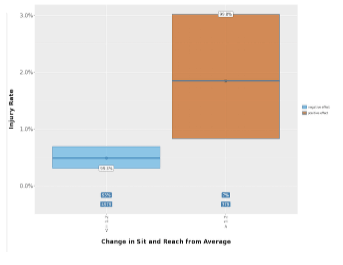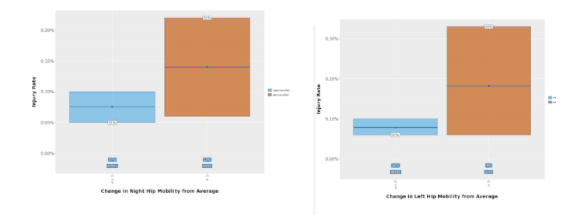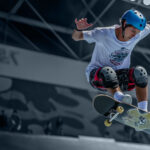Hamstring injuries are a common injury risk in most field sports. The complexity from the dual-demands on the muscle, where actions are either hip-dominant or knee-dominant, has often caused researchers to contradict each other, leaving an incomplete consensus on the risk factors to screen for hamstring injuries.
Recent research from the team at Kitman Labs suggests that a change in muscle activation patterns, resulting from an increased range of motion, may raise a player’s risk of sustaining hamstring injuries. In particular, a player with an increased sit and reach score is 3.79 times more likely to experience a hamstring injury.
By reflecting on these findings Kitman Labs strongly reinforce the importance of continually probing and questioning the data being collected, as every team and it’s build of players is unique.
Introduction
Hamstring strain injuries remain a challenge in team sports due to the high incidence rate, slow healing, and persistent symptoms. Hamstring injuries are particularly common in intermittent sprints sports (Liu, Garrett, Moorman et al., 2012). Rugby, AFL and NFL report hamstring tears among the most severe injuries resulting in substantial time loss.
Players who have sustained a previous hamstring injury are at higher risk of re-injury. Nearly one-third of hamstring injuries recur within the first year following a return to sport, with subsequent injuries often being more severe than the original. Furthermore, players who have sustained a previous hamstring injury are also at increased risk of ACL, hip, groin and other lower limb injuries (Heiderscheit, Sherry, Silder et al., 2010). Modifiable risk factors (that have been suggested from research) include hamstring weakness, fatigue, and lack of flexibility. Additionally, reduced tissue extensibility due to scar tissue formation and motor pattern changes have been associated with rates reinjury.
There has been substantial epidemiological and aetiological investigation examining hamstring injuries in sport, however hamstring injury risk factor research remains confounding (Crosier et al., 2008). Contradiction exists concerning many of these factors. For example, some authors have reported that lack of hamstring strength and flexibility associated with hamstring injury incidence in athletes while other authors have reported no relationship between lack of hamstring strength and flexibility (Verall et al., 2001, Gabbe et al., 2008).
From an applied perspective, understanding hamstring injury risk factors and the veracity of assessment procedures used to measure these risk factors is an important consideration for coaches and support staff working in professional sport. Thus the purpose of this report is to examine the associations between common hamstring function assessments and injury incidence. In doing so we explore the theory underpinning the common hamstring assessment procedures and consider some critical considerations about hamstring injury mechanisms that could influence how we assess the risk of injury.
Hamstring Injury Risk Factors & Assessment:
Research evidence suggests that the hamstring muscles are most vulnerable to injury in the late swing phase of running, where there is a rapid change from eccentric to concentric function. During this latter swing stage the hamstrings are active and absorbing energy from limb deceleration in preparation for foot contact.
From a re-injury perspective, post-injury remodeling can involve scar tissue formation, which may alter contraction mechanics and influence re-injury risk. Specifically, the presence of scar tissue can alter muscle force transmission paths (Huijing, 2003) and decrease the compliance of the tendon/aponeurosis complex. Thus, based on changes in muscle tissue compliance, a decrease in tissue compliance at the musculotendinous junction has been associated with previous injury.
However, caution is warranted when interpreting such research from an applied perspective. Decreased tissue compliance does not equate to decreased muscle flexibility. Decreased hamstring flexibility has been associated with hamstring injury incidence if reduced hamstring flexibility is resultant from anatomical variations in pelvic and lumbar spine positioning. However, other confounding factors must be considered. For example, anthropometrics, age and differences in passive/active activation should also be considered when assessing hamstring injury risk.
For present purposes, we examined the relationship between a passive flexibility test of the hamstring musculature (e.g. sit & reach) and injury incidence.
Hamstring Flexibility: Sit & Reach
The sit and reach test is a commonly deployed hamstring assessment that measures the flexibility of both the lower back and hamstring muscles. Thus the assessment can be used to track tightness occurring from lumbar lordosis, forward pelvic tilt and lower back pain. As mentioned above, lumbar dysfunction can increase load and alter activation patterns of the hamstrings. Lumbar dysfunction can be detected by a decrease in sit and reach distance achieved whilst maintaining pelvic neutrality.
Conversely, a study examining hamstring injury in the AFL found that players who sustained an injury throughout the season revealed a tendency towards greater flexibility, rather than tightness. In particular, those who sustained a further injury were significantly more flexible according to the sit and reach test (p 0.052).
From our data, we have seen trends that suggest a more critical consideration of sit & reach score interpretation is required. For example, we examined sit & reach scores over a duration of three seasons for three rugby union teams.
This data set showed that an increase in sit & reach score from the players average was associated with a higher rate of hamstring game injuries (3.79 times higher) (see Figure 1). No notable relationship between sit & reach and hamstring injury rate was found for hamstring injuries that occurred during training. This could be due to more higher speed running experienced during games.
Figure 1. Change in sit & reach hamstring injury rate (game)
It is important to note that these findings are correlational and not causational, thus to understand the meaning behind these findings, other confounding factors must be considered. For example, workload has been associated with increased muscle tension. Therefore, increased muscle tension and decreased sit & reach may be related to players sustaining a high workload. Appropriately high workload has been associated with reduced risk of injury. Thus, considering whether an increase in sit & reach is due to reduced workload and potential detraining is important when interpreting changes in hamstring flexibility.
Hamstring & hip function: Hip internal rotation
Hamstring injuries that occur during running or kicking activities also involve hip flexion and knee extension. During hip flexion and knee extension, the hamstring is placed in a suboptimal strength position due to the extreme stretch experienced. Sensibly, assessing hamstring injury risk should account for different injury mechanisms i.e. certain tests may be more predisposed to identifying risk factors that are associated with a particular mechanism of hamstring injury. Limited hip extension and mobility has been proposed as a potential cause of both increased anterior pelvic tilt and subsequent exaggerated lumbar lordosis during walking and running.
As with sit & reach, we examined the relationship between hip internal rotation scores and injury rate in rugby union teams over a number of seasons. From the data set we found that an increase in hip internal rotation scores from average was associated with increased rate of hamstring injuries during training but not during games (see Figure 2). This could be reflective of insidious onset of hamstring strains that occur during training compared to more acute hamstring tears that occur during games.
Figure 2. Change in hip internal and hamstring injury rate (training)
Conclusion
Clearly, injury risk identification is complex. Hamstrings have double joint functions (knee and hip) and injuries can originate from maladapted movements at either joint. Many parameters of hamstring function (e.g. strength, power, recruitment pattern, length – strength ratio and mobility) are related to hamstring injury occurrence and several hamstring injury aetiologies exist. To ensure optimisation of injury monitoring, combining professional experience and knowledge with evidence from your own data can help to identify appropriate methods for monitoring risk factors associated with different hamstring injury mechanisms.
From our data we see that certain screening metrics appear to be more strongly related to hamstring injury risk than others. Additionally, the number of exposures for these higher injury rates was low. Furthermore, the relationship between screening metrics and injury risk will vary depending on team, individual and injury characteristics.

REFERENCES
- Askling, C., Karlsson, J., & Thorstensson, A. (2003). Hamstring injury occurrence in elite soccer players after preseason strength training with eccentric overload. Scandinavian journal of medicine & science in sports, 13(4), 244-250.
- Bahr R, Holme I. Risk factors for sports injuries – a methodological approach. Br J Sports Med 2003: 37: 384–392.
- Bennell, K., Wajswelner, H., Lew, P., Schall-Riaucour, A., Leslie, S., Plant, D., & Cirone, J. (1998). Isokinetic strength testing does not predict hamstring injury in Australian Rules footballers. British Journal of Sports Medicine, 32(4), 309-314.
- Croisier, J. L., Ganteaume, S., Binet, J., Genty, M., & Ferret, J. M. (2008). Strength imbalances and prevention of hamstring injury in professional soccer players a prospective study. The American journal of sports medicine, 36(8), 1469-1475.
- Gabbe, B. J., Bennell, K. L., Finch, C. F., Wajswelner, H., & Orchard, J. W. (2006). Predictors of hamstring injury at the elite level of Australian football. Scandinavian journal of medicine & science in sports, 16(1), 7-13.
- Henderson, G., Barnes, C. A., & Portas, M. D. (2010). Factors associated with increased propensity for hamstring injury in English Premier League soccer players. Journal of Science and Medicine in Sport, 13(4), 397-402.
- lzahrani M, et al. Hamstring injuries in athletes: Diagnosis and treatment. The Journal of Bone and Joint Surgery. 2015;3:e5.
- Small, K., McNaughton, L., Greig, M., & Lovell, R. (2010). The effects of multidirectional soccer-specific fatigue on markers of hamstring injury risk. Journal of Science and Medicine in Sport, 13(1), 120-125.
- Verrall, G. M., Slavotinek, J. P., Barnes, P. G., Fon, G. T., & Spriggins, A. J. (2001). Clinical risk factors for hamstring muscle strain injury: a prospective study with correlation of injury by magnetic resonance imaging. British Journal of Sports Medicine, 35(6), 435-439.







